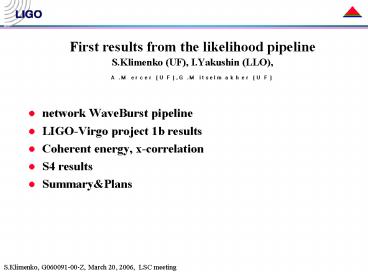First results from the likelihood pipeline PowerPoint PPT Presentation
1 / 19
Title: First results from the likelihood pipeline
1
- First results from the likelihood pipeline
- S.Klimenko (UF), I.Yakushin (LLO),
- A.Mercer (UF),G.Mitselmakher (UF)
- network WaveBurst pipeline
- LIGO-Virgo project 1b results
- Coherent energy, x-correlation
- S4 results
- SummaryPlans
2
Why one more method for burst detection?
- The network WaveBurst pipeline is based on
likelihood method (PRD 72, 122002, 2005) - a coherent method for burst detection
- allows reconstruction of GW waveforms and source
coordinates - works for arbitrary alignment of detectors
3
Search algorithm
- works in time-frequency domain
- likelihood formalism independent for each TF
sample - greatly simplifies calculation of network
response - likelihood time-frequency maps
- time shifts ? use 2D TF time delay filter
pick any pixel with fixed (f,t) and calculate
pixel amplitudes a2(t,f,d) and a3(t,f,d)
time-shifting planes 2 3 by delay d The
amplitudes a1, a2(t,f,d) and a3(t,f,d) are used
to calculate pixel likelihood L(t,f,d)
4
Time-frequency maps
sg250Hz, t0.02sec, q20, f150
apply threshold on likelihood and reconstruct
clusters
5
Coherent WaveBurst
- Similar approach as for incoherent WaveBurst
- Uses most of existing WaveBurst functionality
6
Likelihood sky maps
sg250Hz, t0.02sec, q20, f150, L1/H1/V1
- xxx
7
LIGO-Virgo simulated noise
- Likelihood of triggers on the output of nWB
- different types of injections (SG,GAUSS,SN)
- background -- 101 time shifts (T8726400sec)
2L is the total detected energy
8
Periodic table of burst algorithms
3pl triple coincidence or2 OR of detector
pairs
false alarm rate 1-3 mHz
Fraction () of detected events
A1B2G1 or2 / 3pl A2B4G1 or2 / 3pl gauss1 or2 /3pl gauss4 or2 / 3pl sg235 or2 / 3pl sg820 or2 / 3pl
PF 33 / 9 39 / 10 60 / 17 19 / 7 19 / 3 34 / 13
KW 26 / 6 36 / 9 52 / 13 14 / 4 38 / 6 11 / 2
PC 56 / 14 67 / 19 76 / 30 55 / 23 -- --
EGC 52 / 16 43 / 12 66 / 23 32 / 13 60 / 19 32 / 13
MF 28 / 8 43 / 13 55 / 17 17 / 8 20 / 3 1 / 0
ALF 33 / 9 47 / 14 60 / 20 28 / 12 25 / 3 6 / 2
QT 45 / 20 59 / 23 76 / 35 46 / 18 77 / 39 62 / 32
WBN 41 63 -- 62 82 73
9
maximum likelihood statistic
- Likelihood for Gaussian noise with variance s2 k
and GW waveform u xki detector output, Fk
antenna patterns - Events reconstructed by the pipeline are
coincident in time by construction ? what is
definition of a coincidence?
detector response -
10
real world analysis
- In ideal world where detector noise is always
Gaussian likelihood statistic is sufficient. - In the real world where data is always
contaminated with glitches - the signal
consistency statistics are required - Real world analysis strategy
11
Likelihood distribution
- Ligo-Virgo noise
S4 data
12
Detection performance as ETG
sgQ9 70 100 153 235 361 553 849 1053
WB 4.60 1.32 1.13 1.29 2.04 2.49 3.71 5.00
nWB 2.70 1.23 0.94 1.12 1.65 2.15 3.18 4.01
tuned to FA rate 20mHz by setting threshold
on power in each detector
13
Coherent energy
- Likelihood is a quadratic form
- xi whitened data streams
- Cij depend on antenna patterns and detector
sensitivity. For constraint likelihood
- g network sensitivity
incoherent coherent
14
X-correlation for misaligned detectors
- S-statistic
- Cauchy-statistic
- network global x-correlation coefficient
- Similar to r-statistic the KS test can be applied
15
Network x-correlation
- powerful signal consistency test different from
the NULL stream
16
End-to-End pipeline
- In addition to excess power cuts apply selection
cuts based on the likelihood x-correlation terms - works for arbitrary detector alignment
- False alarm (100 time lags) 0.2 mkHz
- Results are very preliminary
- no DQ flags were applied
- post-processing election cuts are not tuned
sgQ9 70 100 153 235 361 553 849 1053
WBR 4.7 1.4 1.2 1.3 2.1 2.6 3.9 5.4
WBN 3.5 1.5 1.2 1.5 2.2 2.9 4.6 6.1
17
Pipeline performance
- Search over the entire sky with good angular
resolution can be computationally very intensive - nWB pipeline performance for all sky search with
1o resolution (65000 sky locations) and 101 time
lags - cit 2.2GHz 64 bit obteron 1. 0 sec/sec
- Llo 3.4GHz 32 bit Xeon - 1.6 sec/sec
- nWB performance is comparable to the incoherent
WaveBurst pipeline - typical run time on LLO cluster for S4 data is 1
day
18
Summary
- network WaveBurst pipeline (nWB) based on
likelihood analysis is operational. - LIGO-Virgo project 1b data nWB looks good in
ideal world - S4 data results consistent with the standard
WBR pipeline - Excellent computational performance
- x-correlation coefficients can be defined for
arbitrary networks which offers a waveform
consistency test complementary to Null stream
19
Plans
- Finalize tuning of selection cuts S4 data
analysis - study coordinate and waveform reconstruction
- try algorithm on LIGO-GEO and LIGO-Virgo data
- run online coherent search on S5 data
- Produce likelihood statistic for triggered
population search (with S.Mohanty) - perform BH-BH merger search

